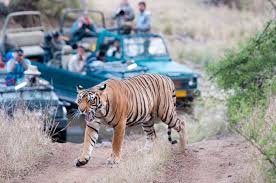10 Tiger safari destinations you should add to your travel wishlist right away

- Similipal National Park, Mayurbhanj, Odisha
Similipal national park, which is also called Similipal tiger reserve, is located in the Mayurbhanj district, which is located in Odisha state. It is a portion of the Mayurbhanj elephant reserve which includes the Similipal tiger reserve, Hadagarh wildlife sanctuary, and Kuldhia national park. An area of 2750.00 km2 surrounds it. Similipal national park is placed as the 7th largest national park in India. The name Similipal is derived from the teemingness of Semul, which means red silk cotton sarees. The park has some attractive waterfalls. Barehipani and Joranda are very famous and very big of all. There are also many small waterfalls which can be considered.
The inland is home to 99 royal Bengal tigers, 432 wild elephants, Gaurs called as Indian Bison, Orchidarium and Chausingha a type of deer. If you want to visit the national park, then you have two options. You can enter via Pithabata which is 22km (14 mi) from Baripada. One can get a permit from the range officer in the Pithabata check gate by paying prescribed fees. The visiting hours for the day visitors are between 6 AM to 12 Noon, and for those who have reservations, the timing is 6 AM to 9 AM. One can also visit Similipal national park via Jashipur. It is a tehsil town in the Mayurbhanj district in Odisha state. You can take SH 49 from Jashipur which is 98 km to Similipal. This is a part of UNESCO since 2009.
- Bandhavgarh National Park, Madhya Pradesh
Bandhavgarh means Brothers fort. It is a park having a booming historical past. The former park was maintained by the maharajas and their guests as Shikargarh or Game Preserve. It is located in Umaria District in the state of Madhya Pradesh. It is surrounded by an area of 105 km 2 and spread across forest divisions of Umaria and Katni with a total of 820 km2. This park holds very big biodiversity. Here the mass of the tiger population is one of the highest in the country. A maximum number of leopards is found in this park. Different types of deers are also found in this national park. In 1951, the king of Rewa, Maharaja Martand Singh caught the first white tiger “Mohan” which is now displayed in the castle of Rewa’s maharaja. There are three zones of the park called Tala, Magadhi, and Khitauli. The Tala zone is full of main tigers. The park started as a national park in 1968, but it took a long to put in the schemes in 1993.
The forests are covered with trees like Sal (Shorea Robusta), Dhobin, Salai, etc. with soupy bamboo thickets together providing wealthy biodiversity. According to the officials, it contains 250 species of birds, 37 mammals, 80 types of butterflies and a huge number of reptiles. One can reach by Jabalpur, which is the nearest city, which is around 199 km and will take around 4.30 hrs.
- Ranthambore National Park, Rajasthan
November and maybe the best time to visit the park. Not only tigers, this park includes fauna like Indian Leopard, sloth bear, striped hyena, mugger crocodile, but southern plains also grey langur and many more. This also gives shelter to many plants, birds, reptiles and the largest banyan tree in India. There are approximately 539 species of flowers. The forests are a dry, deciduous and open grassy meadow. It is a national park located in the northern part of India covering an area of 392 km2. Formerly the park known as Sawai Madhopur Game Sanctuary, it was declared one of the Project Tiger Reserves in 1973 and a national park on 1st1st November in 1980. This park is mainly known for its Bengal tigers. These can easily be spotted in the sun. One can reach the park by Sawai Madhopur district which is 11 km from the park which can be reached by about 110 km from northeast of Kota and 140 km southeast of Jaipur. The safari rides can be out between 6.30 and 14.30, and each ride is approximately 3 hours. You can have a canter or a gypsy which may cost around 900-1400 per person.
There are some good resorts where you can have a break or stay overnight. There are many lakes located therein which Padam Talao is the largest one. You can find a red sandstone Jogi Mahal at the edge of the lake. The gigantic banyan tree near the lake is considered as the 2nd largest in India.
- Kanha National park, Madhya Pradesh
This tiger reserve is one of the largest national parks which is situated in the heart of India, Madhya Pradesh. The national park is divided into two sanctuaries called Hallon and Banjar, which are having an area of 250 and 3002 km respectively. The national park was established on 1st1st June 1955. It was declared as Kanha tiger reserve in 1973. It is stretched over an area of 940 km2. The reserve has a notable population of Indian Leopards, Royal Bengal tigers, Indian wild dogs, Barasingha and sloth bear. The Jungle Book by Rudyard Kipling is based on this reserve. There are over 1000 varieties of flowering plants that might be attractive to some people.
The best season to roam here is between February and June. The park is fully closed from 1st July to Ocobr15th October. Jabalpur airport is the nearest airport, which is 175 km from the park takes around 04.30 hrs to reach the destination.
- Jim Corbett National Park, Uttarakhand
The national park is the oldest among all which covers around an area of 1288 km2. The project tiger was first initiated in this park. Around 488 species of plants and a wide variety of fauna is found in the biodiversity. This is one of the most visited tiger reserves in India. Only selected areas are allowed to roam across the reserve so that the landscapes and wildlife can be enjoyed. The number of visitors is around 70000 in a season. The forest here is very dense and deciduous. Around 50 species of mammals, 580 species of birds, 110 tree species and 25 reptiles and nearly 73% area is covered with park, and 10% is covered with grasslands.
Jeep safaris are the best way to roam around, and it can be rented from Ramnagar. Walking safari may be possible, but there are limitations. There is also a dam in the park named kalagarh Dam.
- Tadoba National Park, Maharastra
The park is considered to be the biggest national park in Maharastra. It gives shelter to mammals like the leopard, tigers, sloth bear, nilgai, striped hyena, gaur, dhole, chital, spotted deer, barking deer, four-horned antelope and around 74 different types of butterflies with 195 types of birds. This national park is located in Chandrapur district in Maharastra. It is spread across an area of about 625 sq km.
The summer is best the best time to spot tigers here. No core area is available are up to roam for visitors, so you can get a better chance to spot the diversity. In the southwest of the park, there is a lake called Taboda lake, which is around 300 acres. This gives shelter to Mugger crocodiles. The reserve covers the Chimur hills surrounded by thick forests. The south of the park is less hilly than the residue.
- Satpura National Park, Madhya Pradesh
The ecosystem of this park is a part of a unique central highland. It was set established in 1981. It is spread around an area of 524 km2. It gives shelter to many leopards and tigers. The forests are very dense, which gives a better home to the mammals. Still, the national park is unexplored; that's why the animals here roam openly without any hesitation. There is a river called Sonbhadra where these big cats come to swim in the river and the water holes. It is one of the few reserves where one can explore the park on foot led by the guide.
Apart from these big cats, it protects hyena, leopard, sambar, barking deer, wild dogs, bears, foxes and many more by its dense forests. One can reach the destination by Piparia via Pachmarhi. The capital city, Bhopal, is 130 miles away.
- Pench National Park, Madhya Pradesh
The number of tigers may be less here, but it is one of the fewest reserves which offers a chance to spot the big cats. The scenic view of the park is one of the best in India. Spread around an area of 257 km2, this park offers vast biodiversity. Spotting the tigers is one of the most interesting parts among animal lovers.
Other animals are spotted like Chausingha, spotted deer and more than 33 species of animals, 50 types of birds and 30 types of reptiles. This may attract the bird lovers as the reserve gives shelter to around 150 species of birds.
- Nagarhole National Park, Karnataka
This reserve may be less considered as a national park, but provides the safest shelter for Indian big cats. The number of tigers is increasing since early 2000. Most of the tigers can be spotted near the bank of the Kabini River, which flows via this park. The area is covered around an area of 643 km. The scenic reserve is located Kodagu District of Karnataka.
The park is home to many mammals like Bengal tiger, Indian leopard, sloth bear, hyena, barking deer, wild boar, and Indian elephant. The forest includes rosewood, sandalwood and silver oak which are commercially important — reptiles like mugger crocodiles, vine snakes, Russel’s viper and many more. It was declared the 37th project in project tiger. The park is covered with small streams, hills, and waterfalls. One can reach by Mysore, which is 30 miles apart from the destination.
- Bandipur National Park, Karnataka
Another best place for the safari, Bandipur national park is stretched over 874 km2, which is famous for its more number of tigers and very rich biodiversity. Approximately 115 tigers are found in the census 2010. On the safari, you will also spot elephants, wild boars, gaurs and some other mammals near the waterholes.
Also, you will find around 230 types of birds, which include woodpecker, sandpiper, falcon, etc. By travelling 80 km from Mysore, you can reach the destination. Bangalore is the nearest city.















































